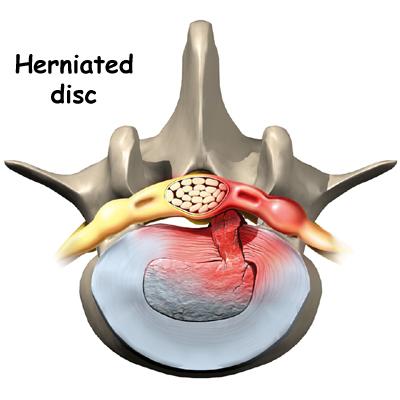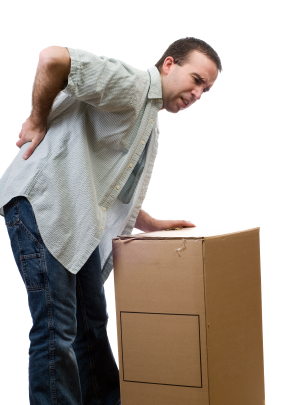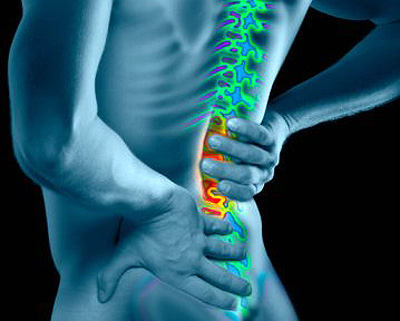Herniated Disc
What is a herniated disc?
As the name suggests, a herniated disc or disc herniation is when the inner disc material (nucleus pulposus) has herniated through the outer layer (annulus fibrosis) of the disc itself. The discs are the shock absorbers of the spine that lie between the bones, which are called vertebrae. The discs consist of a very tough outer layer of cartilage with a soft, jelly-like fluid in the middle.
A great analogy for a spinal disc is to think of it like a jam donut. It has a tougher outer layer of bread and a thinner jam-like fluid in the middle. When excessive force or stress is put on the disc itself, the inner jam-like fluid can puncture or burst through the tougher outer layer containing it. As the discs themselves are so close to the spinal nerve roots, the protruding disc material can directly impact on either the nerve exiting the spine, or the spinal cord itself. When this nerve irritation occurs, significant pain and dysfunction is the most common result. This most commonly occurs in the lower back but can also occur in the neck and thoracic spine.

What causes a herniated disc?
There a number of different stresses that can ultimately lead to a disc herniation. However, the most common reason is as a result of lifting, bending or twisting awkwardly. Traumatic (quick) injury to discs commonly occurs from lifting heavy objects. The load on the disc is increased by lifting with yours knees straight, rather than lifting with your knees bent and a straight back. When you lift and rotate at the same time, even more pressure or load on the disc occurs which can be ten times higher compared to lifting straight up in front of you.
As well as traumatic incidents, disc herniations can also occur due to minor disc stressors sustained over a longer period of time. Minor back pain and chronic back tiredness are often indicators of spinal dysfunction that make you susceptible to herniation on the occurrence of a minor traumatic event, such as bending to pick up a pencil or falling over. When this spinal dysfunction occurs over a longer period of time, the disc can also begin to degenerate. This wear and tear (osteo-arthritis) makes the disc even more susceptible to injury due to minor events.

What does a herniated disc feel like?
Symptoms of a herniated disc can vary depending on the location of the herniation and the amount of nerve irritation that has occurred. They can range from minor pain if the disc is the only tissue injured, to severe and unrelenting neck pain or lower back pain. Pain can also radiate from the irritate nerves into the regions that the nerve supplies. For the lower back, the radiations can be felt in the hips, thighs, knees, legs or feet. Commonly radiating pain is felt down the back of the legs and is referred to as, sciatica. Other symptoms may include numbness, tingling and muscular weakness.
Unlike pain that comes and goes, which can be caused by spinal and pelvic joint dysfunction or muscle spasm, pain from a herniated disc is usually continuous or severely aggravated by certain positions. Typically, symptoms are experienced only on one side of the body. If the herniation is very large and presses on the spinal cord, a condition called cauda equina syndrome can occur on rare occasions. The cauda equina is the name for the tail of the spinal cord in the lower back. Compression of the cauda equina due to a large disc herniation can result in the loss of bowel and bladder control due to nerve damage. If you or someone you know is experiencing these symptoms then immediate medical attention is required to avoid permanent nerve damage and loss of function.

How can Spinecare Chiropractors help with herniated discs?
Chiropractic care has consistently been shown to be effective in reducing the pain and disability of disc injuries in the short and long term, by addressing the overall biomechanical function of the spine and pelvis. Spinecare’s Adelaide chiropractors can initially help by providing a thorough spinal examination to determine the cause and possible type of disc injury during Your Initial Consultation. Once the cause and possible disc problem is determined, our Adelaide chiropractor’s will sit down and explain your findings so that you know exactly what we believe is the problem during Your Report of Findings.
Our chiropractor’s will recommend a course of care if chiropractic is appropriate and outline their expectations before beginning any treatment. Spinecare Chiropractic prides itself on providing safe, professional and painless treatment for disc related pain relief. As well as our work in the clinic, our chiropractors may also provide advice, stretches or exercises that may speed up your recovery and reduce the chance of future relapses.


